DCPA NEWS CENTER
Enjoy the best stories and perspectives from the theatre world today.
Enjoy the best stories and perspectives from the theatre world today.
If you have seen any DCPA Theatre Company production over the past 17 years, you have seen the work of retiring Properties Director Robin Lu Payne.
The candy-dispensing skull in You Can’t Take it With You. The hilarious plaster casting of actor Kathleen M. Brady as Domina in A Funny Thing Happened on the Way to the Forum. That “super weird” dental chair she found in a Kansas barn for The Who’s Tommy. The life-size crucifix from Jesus Hates Me. The old truck seat she dug out of the mud of a Brighton field for Sweat because its distressing was just perfect.
All were either made, borrowed, found or procured by Payne, a woman who left the teaching profession to join the Denver Center for the Performing Arts in 2005 but, her loyal staff says, never stopped teaching.
“Once a teacher,” said Props Artisan Ashley Lawler, “always a teacher.”
Seen above: Photos from a few referenced productions with props managed by Payne.
Props, or “stage properties,” is an often misunderstood theater art that, as Payne explains it, “involves everything on the stage except the walls and the floor.” Of her own job description, she specifies: “I am responsible for making sure all of the items classified as props that go on stage get there according to the designer’s specifications and the play’s requirements on time and on budget.”
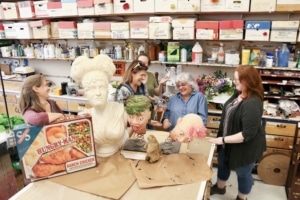
Photo by John Moore
But what is a prop, exactly, as opposed to, say, a piece of scenery? The definitions vary from theatre company to theatre company but, in general: A prop is anything an actor comes into contact with that’s not bolted to the floor. And sometimes, even when it is.
“People sometimes think a prop is just a book or a candle – and those are props,” Payne said. “But they don’t always realize that we actually build very specific things for a very specific purpose at a very specific size and from a very specific period.”
A prop might be something as small as a pen or a pistol. It might be something as big as the tricked-out Cadillac that floated on the ocean in black odyssey. A prop is sometimes an animal (alive or not); sometimes food (real or not). But Payne understands how it can seem confusing to people. Like, did you know that if a statue is larger than 10 feet tall, it is a piece of scenery…but if it’s smaller than that, it’s a prop?
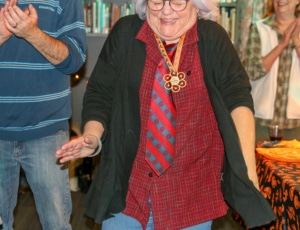
Photo by John Moore
And then there’s blood (and other bodily fluids). If blood comes out of an actor’s mouth or from a stage wound, it is an issue for the costume department. If it gushes out of a device (like the infamous “Vomitron” in God of Carnage, which calls for a woman to start spontaneously projectile-vomiting)…it’s a props problem. Same if it spills through the floor or squirts out of a sofa.
If a scene calls for a chandelier, it will be drawn up by the scenic designer, but produced and presented by the props team. Whether it lights up is a matter for the lighting department.
Almost every theatrical element involves a collaboration between the director, their scenic, lighting and sound designers – and all of their departments. Which is what Payne has loved most about her ever-changing, ever-creative career.
“The best part about props is you get to work with all these different artistic people from all these different departments and you get to create using all these different mediums,” she said.
Oh, and she gets to shop. A lot. Antique stores, flea markets, Craigslist…barns in Kansas.
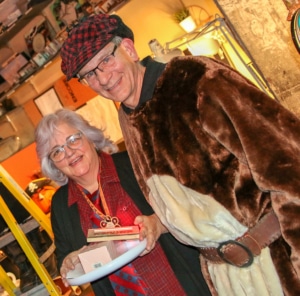
Photo by John Moore
“Shopping is a really big responsibility, and I share that duty with (Props Artisan) Jamie Curl,” Payne said. Although the simple art of buying stuff is not so simple in the age of COVID, inflation and supply shortages.
“Even before the pandemic, the cost of fabric had gone up 300 percent over the past few years,” Payne said. “It’s harder to get lumber. Paint has been hit really hard. Everything is more expensive. So we just have to come up with different ways of making things.
“And we are having to do more and more of our shopping online because there isn’t a fabric store left anywhere in the metro area. No one is making anything anymore, so we have to buy more and more online.”
As the DCPA Theatre Company’s Properties Director – a title Payne has held since her first day here in 2005 – she manages a staff of five. That means hiring, scheduling, budgeting, meetings, research, drafting, shopping, inventory…and providing shop treats.
She’s also in charge of a massive warehouse in northwest Denver that, for one example, stores more than 850 chairs. That’s not including stools or benches. Chairs. But when you need just the right sofa, Payne said, her department is very lucky to have dozens in storage to choose from – and so are theatregoers.
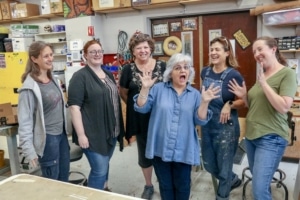
Photo by John Moore
“We would never be able to dress half our sets without the stock we have,” she said. “When you consider what it would cost to go out and get just the right period sofa, well…let’s just say our budget would have to triple or even quadruple if that warehouse wasn’t there.”
And as her retirement day approached (Sept. 9), Payne assumed one additional essential job responsibility: Training her hand-picked replacement, Meghan Markiewicz, who calls Payne’s loss incalculable.
“What walks out that door is a wealth of knowledge that is just absolutely irreplaceable,” Markiewicz said. “She knows where to buy everything, how much it should cost, whether there is a local distributor – we are talking thousands of things.”
But chin up, reminds Props Artisan Georgina Kayes. “It’s not like she’s going anywhere,” she said. (Well, only to Westminster.) “We can still text her.”
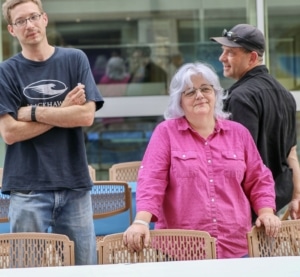
Photo by John Moore
Markiewicz not only has to replace Payne, she has to replace herself on the crew. It’s an eclectic band of craftspeople who come to the table with very different experiences and skill sets.
Payne says the ideal props artisan is an artistic person who demonstrates patience, curiosity, even-keeled tenacity and flexibility. They are detail-oriented tinkerers who are by nature collaborative, love research and possess random skills ranging from upholstery to painting, welding, painting, carpentry, furniture-making and (faux!) taxidermy. They also have to be capable of working on as many as six upcoming productions at once on very tight deadlines.
Which makes them about as easy to find as an old truck seat in the mud.
Showing a real prop-ensity
Payne was born in Redwood City, Calif., and moved to Wisconsin at age 10. She graduated from the University of Wisconsin Milwaukee and got her master’s degree in theatre design and technology from Temple University in Philadelphia. She was too shy to ever feel a jones to perform, but she found her forever home backstage in high school.
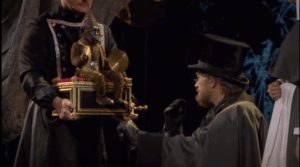
Phantom of the Opera. Photo courtesy of Playbill
She landed a series of impressive internships in college, including the Guthrie Theatre in Minnesota, and then headed for New York, where seven years of steady freelance jobs building props for Broadway productions awaited her.
Payne worked on the first US production of The Phantom of the Opera in New York and can proudly claim to have built the very first (American) monkey music box – the one with the creepy cymbal-crashing primate that plays a haunting song reminding the Phantom of his mommy. She also contributed to the original Broadway production of Les Misérables by making “a lot of flags and dead bodies,” she said. It was all fertile training for her future life in Denver.
“My first real eye-opening experience working on Broadway was when we built the boat for Phantom,” Payne said. The boat was radio-controlled and had to move around the stage. “So it started with the scene shop, which built the boat. Then it came to our props shop, where we decorated it. Then it had to go to the painters. Then it had to go to lighting so they could wire up the lantern. Then it had to go back to the scene shop so they could wire it to the motor.
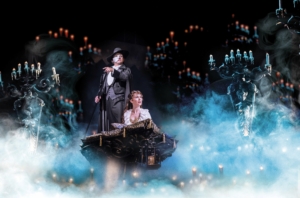
Photo courtesy of Phantom of the Opera
“That boat made trips to all the boroughs in New York City as it was being made. And that shows just how collaborative the creative process can be – and should be.”
Payne was lured out of New York by an even greater passion – for teaching. She developed the properties program at the University of Delaware, where she taught and designed shows for 15 years while summering with the Santa Fe Opera. In 2005, she was recruited by then-DCPA Technical Director Dan McNeil to run the props department at the Denver Center, where she has earned an endearing nickname since.
“I call her ‘Eagle-Eyed Robin,’ because she notices when any little detail is off,” said Props Artisan Nikki Mayer. “She has an eye and a brain for all the details. Even if something just doesn’t feel right, Robin always knows it. She just has an unbelievable gift for knowing and translating what every designer wants.”
And every one of those scenic designers is different. Some don’t want to deal with props at all, while others want to oversee most every decision. But while Payne was never a scenic designer of record, Kayes added, “she is a designer herself, because of her extensive training. Robin can’t go to the scenic designer with every little question, so she is making dozens of really important design decisions every day.”
The next chapter
Payne, one of the least-recognized long-timers on the DCPA staff, has never been in it for the notoriety. She’s been in it for the camaraderie, and the opportunity to contribute to the making of art at the highest level. That might mean filling every desk drawer with meaningful items that the audience will never see. Or making sure the letter an actor might have to read is written to a level of precision only the actor will notice.
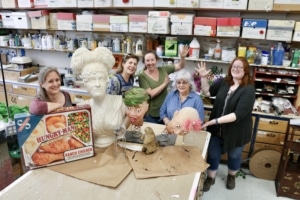
Photo by John Moore
“It’s always been my commitment to have every production be the best it can be, and if that means writing actual letters that only the actors can see, then that’s what we do,” Payne said. “You have to understand that the level of detail is not for the audience’s benefit. It’s to help the actors in their journey. Our commitment is to make the world as authentic as it can be so that the actors can be as authentic as they can be in every moment.”
Payne is hoping to focus her newfound free time on her artistic medium of choice, which is sculpting at her home in Westminster. (Look out, Halloween pumpkins.) But as a person who has spent her entire career practicing one of the theater’s hidden arts, it only seems right for Payne to have the last word in the telling of her own story.
“The biggest thing that I would want others to know is that the majority of people who choose to work in this field are all highly educated, committed, skilled artists who are experts in their crafts,” she said. “And they are doing it on purpose.”
